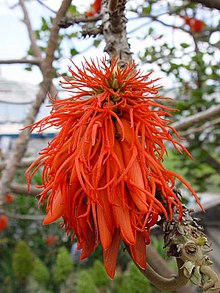Erythrina abyssinica
| Erythrina abyssinica | |
|---|---|

| |
| Scientific classification | |
| Kingdom: | |
| (unranked): | |
| (unranked): | |
| (unranked): | |
| Order: | |
| Family: | |
| Genus: | |
| Species: | E. velutina
|
| Binomial name | |
| Erythrina abyssinica | |
| Synonyms | |
|
Erythrina tomentosa R.Br. | |
Erythrina abyssinica is a tree species of the genus Erythrina belonging to the plant family of the Fabaceae (or Leguminosae) described by Augustin Pyramus de Candolle in 1825. This leguminous tree species is native to East Africa , Eastern DRC and southern Africa.
History
The description of E. abyssinica has been complicated, because the first specimen of Erythrina from Ethiopia (Abyssinia) brought to Europe was actually a mix of the two species. The flowers and leaves belonged to E. brucei Schweinfurth (1868) and the pod and seeds to E. abyssinica Lam. ex DC (1825). In addition, the first three descriptions were invalid, i.e. not published correctly to the International Code of Nomenclature for algae, fungi, and plants (syn. E. kuara James Bruce (1790), E. abyssinica Lam.[1] (1786) and E. tomentosa Robert Brown (1814)). Furthermore, the species is variable with individuals with glabrous and hairy (tomentose) leaves which were described separately and after revision resulted in additional synonyms (syn. E. tomentosa R. Brown ex A. Rich. (1847)). The number of synonyms increased when a new genus was described from South Africa (Chirocalyx Meisn.), which later was considered synonymous with Erythrina (Ch. tomentosa Hochstetter and Ch. abyssinica Hochstetter). Finally, E. abyssinica was considered for some time the juvenile stage of E. brucei and hence synonymous with the latter species. The issue was settled in 1962 when the pods and seeds from E. brucei were collected which were different from those of E. abyssinica. Consecutively, the seeds planted revealed that seedlings and saplings of E. brucei did not resemble those of E. abyssinica.[2]
References
- ^ Lamarck, J.B. (1786) Encyclopédie Méthodique (Lamarck) 2(1): 392.
- ^ Gillett JB. (1962). "The fruit and seeds of Erythrina brucei and the identity of E. abyssinica". Kew Bulletin. 15 (3): 425–29. doi:10.2307/4115612. JSTOR 4115612.
External links
- Dressler, S.; Schmidt, M. & Zizka, G. (2014). "Erythrina abyssinica". African plants – a Photo Guide. Frankfurt/Main: Forschungsinstitut Senckenberg.
